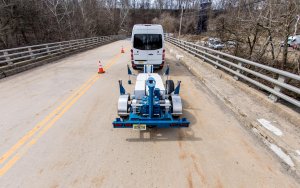
THMPER bridge testing device.
On Wednesday, September 16th, from 2-3 pm, Rutgers Center for Advanced Infrastructure and Transportation (CAIT) will host the next installment of its ongoing seminar series on the state of the art in nondestructive evaluation (NDE) and other technologies for the assessment of concrete bridges. CAIT-affiliated researcher Dr. Nenad Gucunski will lead the discussion. Learn more and register here.
Effective and economic management of bridges depends on accurately assessing their current condition, and, in turn, predicting their future performance. Deterioration processes in reinforced concrete, since they are a result of multiple inputs and actions, are inherently complex. To fully and accurately characterize various types of deterioration, and gauge its severity, it requires the use of multiple NDE tools in concert with other technologies.
Those NDE technologies can be effectively used in the assessment of all bridge components. However, among all the components, reinforced concrete decks deteriorate fastest, primarily due to their direct exposure to traffic and environmental loading, and maintenance actions. Therefore, the most significant advancements in NDE technologies’ efficacy for detecting and characterizing deterioration, including the automation of data collection, were achieved for bridge decks. Those advances enable a more objective description of the current condition and allow us to predict the progression of deterioration more precisely. However, it also has been shown that bridge performance varies widely, even between bridges that are very close in age, and that have similar traffic loads, designs, and other conditions. Additional influences require examination. The complemental use of NDE, SHM, and other technologies for local and global assessment will provide the complete answers regarding disparate bridge performance.
This webinar will provide an overview of the advances in NDE technologies, especially those employing rapid and automated data collection and analysis, and benefits for bridge management stemming from periodical multi-NDE technology surveys. The presentation will also explore the ways to gain additional knowledge about bridge performance through the complemental use of NDE and other technologies.

